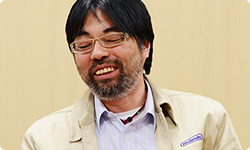3. Sugiyama-san Says ''No!''
Of the three modes, first I’d like to ask about Missions . The basis for that was the technical demo at the E3 2004, right?
Yes. Submarine movement has inertia, so we made Missions with a desire for players to discover the pleasure of feeling as if they are actually operating a submarine. You have to clear missions in this mode, so I hope players will play them over and over again to polish up their technique.
You want them to improve their submarine-piloting skills.
Exactly.
Imamura-san, earlier you said that you added levels. What did you keep in mind as you remade this mode?
Sugiyama-san’s team had made a technical demo, so the course was short. We made the courses three times as long, but when the scale changed, so did the way the game felt as you played.
It sort of dragged on?
Yes, that’s right. So I kept asking Sugiyama-san if we should make it so players collected items, but he stoically replied “No!”
He shot it down?
I thought it would be fine to set the game in a flashy, glittery world like - and I’m not kidding - a submarine version of Mario Kart. But Sugiyama-san said, “No!”

So there was a big gap between the way Sugiyama-san thought of the game as the creator of its foundation and the way you imagined it as a packaged game.
A big gap.
At first, I wanted players to enjoy operating as if by radio control, and I was very specific about that. I was certain it wasn’t a game for collecting items.
But what I originally had in mind wasn’t so much radio control as moving around a real, large submarine. But since it was going to be packaged, we started making more of a small submarine that responded well. When we headed in that direction, however, the operability got easier and easier, and lots of people started wondering why we couldn’t just control it with the Circle Pad. Then it really would be like Mario Kart.
It would lose its distinctive appeal.
Right. It would become one side-scroller among others. If that’s what had happened, they might just figure they could play something else. That wasn’t an option for me this time. So when we made the small submarine, I warned everyone not to make the controls too sleek.
Just because it’s small, it can’t zip and zoom all over.
Then it wouldn’t be a submarine.
We were adjusting the parameters controlling the submarine’s movement right up until the very end. But when you’re playing it for long periods of time, you start thinking, “If we raise the parameters here, the increased speed would feel great,” and “If only I could use the +Control Pad ...” and you almost give in to those temptations. Every time, though, Sugiyama-san would say, “It’s fine the way it is!”
He reined you in.
Yeah. But I couldn’t help it. I thought moving the levers needed to feel lighter. So without telling Sugiyama-san, I...
You secretly made them lighter. (laughs)
Yeah. But when I showed the game to him, he noticed right away! (laughs)
(laughs)
They didn’t feel right that way. (laughs) Things like that...
I suppose it didn’t feel like you were operating something big and heavy like a submarine.
Right. If felt like something was missing.
You can’t feel the submarine’s weight unless they move slowly.
But members of Mario Club Co., Ltd.11 also said they were slow and didn’t respond well. 11Mario Club Co., Ltd. performs debugging, testing and so on for Nintendo’s software under development.
Oh, that’s right.
So we lightened the levers up again, but when you played the game, it didn’t match the speed of the vessel. We returned them back the way they were, but everyone kept saying it needed to be lighter or faster...
They just kept saying that it needed to be simpler and faster.
But if you made it simpler and faster, it wouldn’t be as realistic.
Right. So my response was “Fine. We made it simpler and faster. But now I’m going to make it more difficult!” (laughs) If we made it simpler and faster but didn’t speed up the movement of the enemies, it wouldn’t be balanced. I thought, “Stick with it. You’ll gradually get a feel for what makes it fun.”

All sorts of instruments are lined up on the Touch Screen. Once you master those, it really feels like you’re piloting a submarine.
They’re tools. The player, who’s the captain, is busy! (laughs) The player has to do lots of things and issue lots of commands, because everything is the captain’s responsibility. And the levers don’t just slip into place, they sort of grind. Imamura-san, you guys put some work into that, didn’t you?
Yeah. Sugiyama-san hounded us about that. (laughs)
Our hope is that once players finish playing it, they’ll beg to operate an even larger submarine.
Once you master sub operation, you feel like piloting something heavier and more difficult.
Yeah.
As you were playing it during development, were you able to slip through narrow places even with a larger submarine?
At first, we put a lot of thought into how to pull the Missions mode together. I wanted to make it like F-Zero.
Like F-Zero?
Yeah. (laughs) Take a chicane (a curved road), for example. When you go through one, inertia grips you, so you have to turn in advance, like you’re drifting...
Uh-huh.
It’s like a slow version of F-Zero. (laughs)
F-Zero in slow motion. (laughs)
Yeah, that’s right. I wanted the Missions mode to turn out like that!
